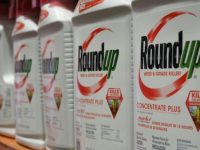 I have noticed here in Africa that most people tend to follow the idea that more is better. Certainly more is not better when it comes to chemicals. Weedkiller is a special case to use less and less of and preferably none. Unfortunately Africans are killing Africans with the misuse of so many unnatural things. The article below from Environmental Health News should cause the warning bells to go off for those who use weedkiller and those who eat the food sprayed with weedkiller: http://www.environmentalhealthnews.org/ehs/news/roundup-weed-killer-is-toxic-to-human-cells.-study-intensifies-debate-over-inert-ingredients
I have noticed here in Africa that most people tend to follow the idea that more is better. Certainly more is not better when it comes to chemicals. Weedkiller is a special case to use less and less of and preferably none. Unfortunately Africans are killing Africans with the misuse of so many unnatural things. The article below from Environmental Health News should cause the warning bells to go off for those who use weedkiller and those who eat the food sprayed with weedkiller: http://www.environmentalhealthnews.org/ehs/news/roundup-weed-killer-is-toxic-to-human-cells.-study-intensifies-debate-over-inert-ingredients
By Crystal Gammon
Environmental Health News
June 22, 2009
Used in yards, farms and parks throughout the world, Roundup has long been a top-selling weed killer. But now researchers have found that one of Roundup’s inert ingredients can kill human cells, particularly embryonic, placental and umbilical cord cells.
The new findings intensify a debate about so-called “inerts” — the solvents, preservatives, surfactants and other substances that manufacturers add to pesticides. Nearly 4,000 inert ingredients are approved for use by the U.S. Environmental Protection Agency.
Glyphosate, Roundup’s active ingredient, is the most widely used herbicide in the United States. About 100 million pounds are applied to U.S. farms and lawns every year, according to the EPA.
Until now, most health studies have focused on the safety of glyphosate, rather than the mixture of ingredients found in Roundup. But in the new study, scientists found that Roundup’s inert ingredients amplified the toxic effect on human cells—even at concentrations much more diluted than those used on farms and lawns.
One specific inert ingredient, polyethoxylated tallowamine, or POEA, was more deadly to human embryonic, placental and umbilical cord cells than the herbicide itself – a finding the researchers call “astonishing.”
“This clearly confirms that the [inert ingredients] in Roundup formulations are not inert,” wrote the study authors from France’s University of Caen. “Moreover, the proprietary mixtures available on the market could cause cell damage and even death [at the] residual levels” found on Roundup-treated crops, such as soybeans, alfalfa and corn, or lawns and gardens.
The research team suspects that Roundup might cause pregnancy problems by interfering with hormone production, possibly leading to abnormal fetal development, low birth weights or miscarriages.
Monsanto, Roundup’s manufacturer, contends that the methods used in the study don’t reflect realistic conditions and that their product, which has been sold since the 1970s, is safe when used as directed. Hundreds of studies over the past 35 years have addressed the safety of glyphosate.
“Roundup has one of the most extensive human health safety and environmental data packages of any pesticide that’s out there,” said Monsanto spokesman John Combest. “It’s used in public parks, it’s used to protect schools. There’s been a great deal of study on Roundup, and we’re very proud of its performance.”
The EPA considers glyphosate to have low toxicity when used at the recommended doses.
“Risk estimates for glyphosate were well below the level of concern,” said EPA spokesman Dale Kemery. The EPA classifies glyphosate as a Group E chemical, which means there is strong evidence that it does not cause cancer in humans.
In addition, the EPA and the U.S. Department of Agriculture both recognize POEA as an inert ingredient. Derived from animal fat, POEA is allowed in products certified organic by the USDA. The EPA has concluded that it is not dangerous to public health or the environment.
The French team, led by Gilles-Eric Seralini, a University of Caen molecular biologist, said its results highlight the need for health agencies to reconsider the safety of Roundup.
“The authorizations for using these Roundup herbicides must now clearly be revised since their toxic effects depend on, and are multiplied by, other compounds used in the mixtures,” Seralini’s team wrote.
Controversy about the safety of the weed killer recently erupted in Argentina, one of the world’s largest exporters of soy.
Last month, an environmental group petitioned Argentina’s Supreme Court, seeking a temporary ban on glyphosate use after an Argentine scientist and local activists reported a high incidence of birth defects and cancers in people living near crop-spraying areas.
Scientists there also linked genetic malformations in amphibians to glysophate. In addition, last year in Sweden, a scientific team found that exposure is a risk factor for people developing non-Hodgkin lymphoma.
Inert ingredients are often less scrutinized than active pest-killing ingredients. Since specific herbicide formulations are protected as trade secrets, manufacturers aren’t required to publicly disclose them. Although Monsanto is the largest manufacturer of glyphosate-based herbicides, several other manufacturers sell similar herbicides with different inert ingredients.
The term “inert ingredient” is often misleading, according to Caroline Cox, research director of the Center for Environmental Health, an Oakland-based environmental organization. Federal law classifies all pesticide ingredients that don’t harm pests as “inert,” she said. Inert compounds, therefore, aren’t necessarily biologically or toxicologically harmless – they simply don’t kill insects or weeds.
Kemery said the EPA takes into account the inert ingredients and how the product is used, whenever a pesticide is approved for use. The aim, he said, is to ensure that “if the product is used according to labeled directions, both people’s health and the environment will not be harmed.” One label requirement for Roundup is that it should not be used in or near freshwater to protect amphibians and other wildlife.
But some inert ingredients have been found to potentially affect human health. Many amplify the effects of active ingredients by helping them penetrate clothing, protective equipment and cell membranes, or by increasing their toxicity. For example, a Croatian team recently found that an herbicide formulation containing atrazine caused DNA damage, which can lead to cancer, while atrazine alone did not.
POEA was recognized as a common inert ingredient in herbicides in the 1980s, when researchers linked it to a group of poisonings in Japan. Doctors there examined patients who drank Roundup, either intentionally or accidentally, and determined that their sicknesses and deaths were due to POEA, not glyphosate.
POEA is a surfactant, or detergent, derived from animal fat. It is added to Roundup and other herbicides to help them penetrate plants’ surfaces, making the weed killer more effective.
“POEA helps glyphosate interact with the surfaces of plant cells,” explained Negin Martin, a scientist at the National Institute of Environmental Health Sciences in North Carolina, who was not involved in the study. POEA lowers water’s surface tension–the property that makes water form droplets on most surfaces–which helps glyphosate disperse and penetrate the waxy surface of a plant.
In the French study, researchers tested four different Roundup formulations, all containing POEA and glyphosate at concentrations below the recommended lawn and agricultural dose. They also tested POEA and glyphosate separately to determine which caused more damage to embryonic, placental and umbilical cord cells.
Glyphosate, POEA and all four Roundup formulations damaged all three cell types. Umbilical cord cells were especially sensitive to POEA. Glyphosate became more harmful when combined with POEA, and POEA alone was more deadly to cells than glyphosate. The research appears in the January issue of the journal Chemical Research in Toxicology.
By using embryonic and placental cell lines, which multiply and respond to chemicals rapidly, and fresh umbilical cord cells, Seralini’s team was able to determine how the chemicals combine to damage cells.
The two ingredients work together to “limit breathing of the cells, stress them and drive them towards a suicide,” Seralini said.
The research was funded in part by France’s Committee for Research and Independent Information on Genetic Engineering, a scientific committee that investigates risks associated with genetically modified organisms. One of Roundup’s primary uses is on crops that are genetically engineered to be resistant to glyphosate.
Monsanto scientists argue that cells in Seralini’s study were exposed to unnaturally high levels of the chemicals. “It’s very unlike anything you’d see in real-world exposure. People’s cells are not bathed in these things,” said Donna Farmer, another toxicologist at Monsanto.
Seralini’s team, however, did study multiple concentrations of Roundup. These ranged from the typical agricultural or lawn dose down to concentrations 100,000 times more dilute than the products sold on shelves. The researchers saw cell damage at all concentrations.
Monsanto scientists also question the French team’s use of laboratory cell lines.
“These are just not very good models of a whole organism, like a human being,” said Dan Goldstein, a toxicologist with Monsanto.
Goldstein said humans have protective mechanisms that resist substances in the environment, such as skin and the lining of the gastrointestinal tract, which constantly renew themselves. “Those phenomena just don’t happen with isolated cells in a Petri dish.”
But Cox, who studies pesticides and their inert ingredients at the Oakland environmental group, says lab experiments like these are important in determining whether a chemical is safe.
“We would never consider it ethical to test these products on people, so we’re obliged to look at their effects on other species and in other systems,” she said. “There’s really no way around that.”
Seralini said the cells used in the study are widely accepted in toxicology as good models for studying the toxicity of chemicals.
“The fact is that 90 percent of labs studying mechanisms of toxicity or physiology use cell lines,” he said.
Most research has examined glyphosate alone, rather than combined with Roundup’s inert ingredients. Researchers who have studied Roundup formulations have drawn conclusions similar to the Seralini group’s. For example, in 2005, University of Pittsburg ecologists added Roundup at the manufacturer’s recommended dose to ponds filled with frog and toad tadpoles. When they returned two weeks later, they found that 50 to 100 percent of the populations of several species of tadpoles had been killed.
A group of over 250 environmental, health and labor organizations has petitioned the EPA to change requirements for identifying pesticides’ inert ingredients. The agency’s decision is due this fall.
“It would be a big step for the agency to take,” said Cox. “But it’s one they definitely should.”
The groups claim that the laws allowing manufacturers to keep inert ingredients secret from competitors are essentially unnecessary.
Companies can determine a competitor’s inert ingredients through routine lab analyses, said Cox.
“The proprietary protection laws really only keep information from the public,” she said.





